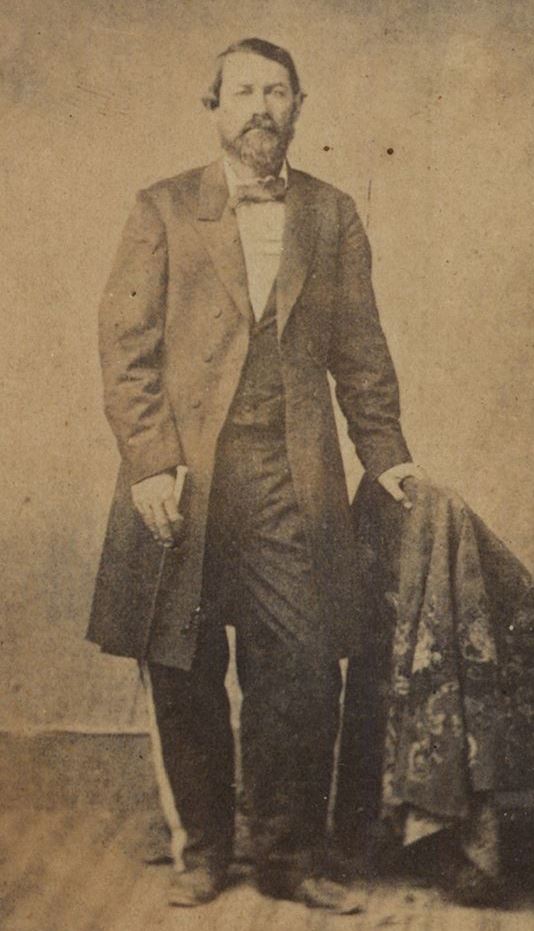Juan Nepomuceno Cortina and the “First Cortina War”
Juan Cortina was born to a cattle-ranching family in the state of Tamaulipas, Mexico in 1824. When he was still young, Cortina’s mother inherited portions of a large land grant in the lower Rio Grande valley, including the area that surrounded Brownsville, to which the family relocated. Like many of his contemporaries, Cortina objected to the unfair treatment that landowners of Mexican descent received in Texas following the Treaty of Guadalupe Hidalgo in 1848, leading in 1859 to a series of violent confrontations collectively called the “First Cortina War.” In late September, after having shot local marshal Robert Shears, Cortina led a party of armed men who seized the town of Brownsville. A counter posse called the “Brownsville Tigers” formed to oppose Cortina’s force and he abandoned the town, fleeing to the family ranch. There, in November, Cortina easily routed the attacking Brownsville Tigers. Soon after, a company of Texas Rangers attempted to take Cortina, but he defeated them as well.
In the following month, a second group of Rangers led by Captain John "Rip" Ford arrived and joined with U.S. forces at Fort Brown. Cortina retreated up the Rio Grande. On December 27, 1859 the combined army and ranger force engaged him in the Battle of Rio Grande City. Cortina's forces were decisively defeated and Cortina fled into Mexico. In one final blow against his enemies, Cortina attempted to capture the steamboat Ranchero, owned and operated by two of his antagonists, Richard King and Mifflin Kenedy, only to be defeated again on February 4, 1860 in the Battle of La Bolsa. He then remained in Mexico, only to return when the Civil War opened new opportunities to pursue old grievances. It was as a result of Cortina’s activities that Colonel Robert E. Lee (USA) visited Ringgold Barracks in 1860.
Listen
Juan Cortina nació en el seno de una familia de rancheros del Estado de Tamaulipas, México, en 1824, y siendo aún él joven, su madre heredó porciones de una gran concesión de tierras en El Valle del bajo Río Grande, que incluían zonas de los alrededores de Brownsville. Allí se mudó su familia y, al igual que muchos de sus contemporáneos, Cortina se opuso al injusto tratamiento que los terratenientes de origen mexicano recibían en Texas después del Tratado de Guadalupe Hidalgo en 1848. Esta situación condujo en 1859 a un conjunto de confrontaciones violentas denominado la «Primera Guerra de Cortina». A finales de septiembre, después de haber disparado al agente de la autoridad Robert Shears, Cortina dirigió un contingente armado que tomó la ciudad de Brownsville, donde se formó una contrainsurgencia para repeler las fuerzas de Cortina bajo el nombre de «Los Tigres de Brownsville». Cortina abandonó la ciudad refugiándose en el rancho de su familia y, desde allí, en el mes de noviembre, reanudó el ataque contra Los Tigres de Brownsville. Poco después, una compañía de los Texas Rangers intentó apresarlo, aunque fue capaz de derrotarlos también.
Durante el mes siguiente, un segundo contingente de Rangers al mando del capitán John «Rip» Ford se unió a las fuerzas de los Estados Unidos acuarteladas en Fort Brown y Cortina se retiró río arriba. El 27 de diciembre de 1859, las fuerzas conjuntas del Ejército y de los Rangers le plantaron cara en la Batalla de Río Grande City, en la que el contingente cortinista fue doblegado de manera definitiva, obligando a Cortina a emprender la huida hacia México. En una última arremetida contra sus enemigos, Cortina intentó capturar el vapor llamado Ranchero, embarcación propiedad de dos de sus antagonistas, Richard King y Mifflin Kenedy, pero volvió a ser derrotado el 4 de febrero de 1860 en el enfrentamiento que tuvo lugar en La Bolsa. Permaneció entonces en México, sólo para regresar cuando el estallido de la Guerra de Secesión de EE. UU. le abrió nuevas oportunidades para resarcirse de sus viejos agravios. Fue como resultado de las actividades cortinistas que el coronel Robert E. Lee, cuando aún era oficial del ejército federal, visitó en 1860 los barracones de Ringgold.

